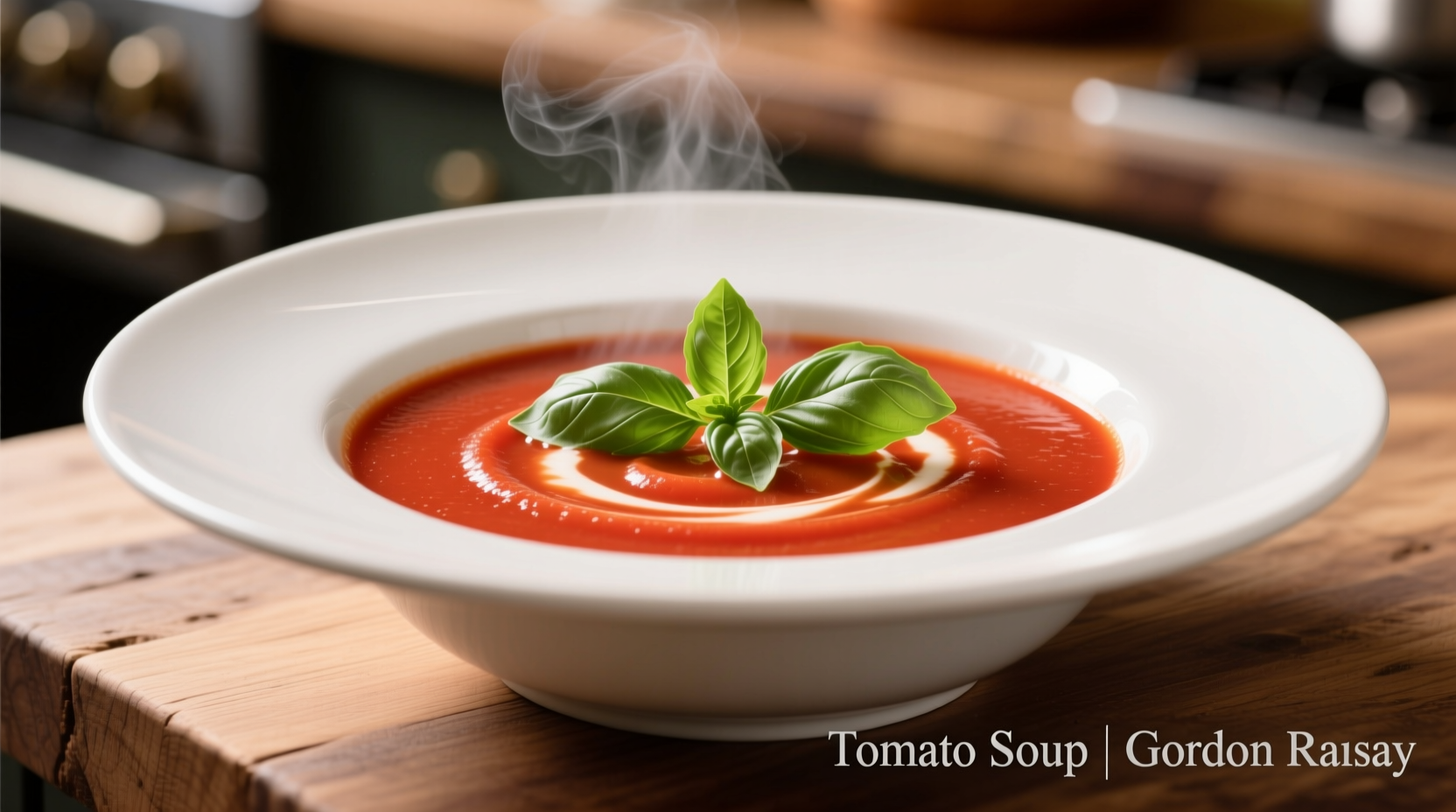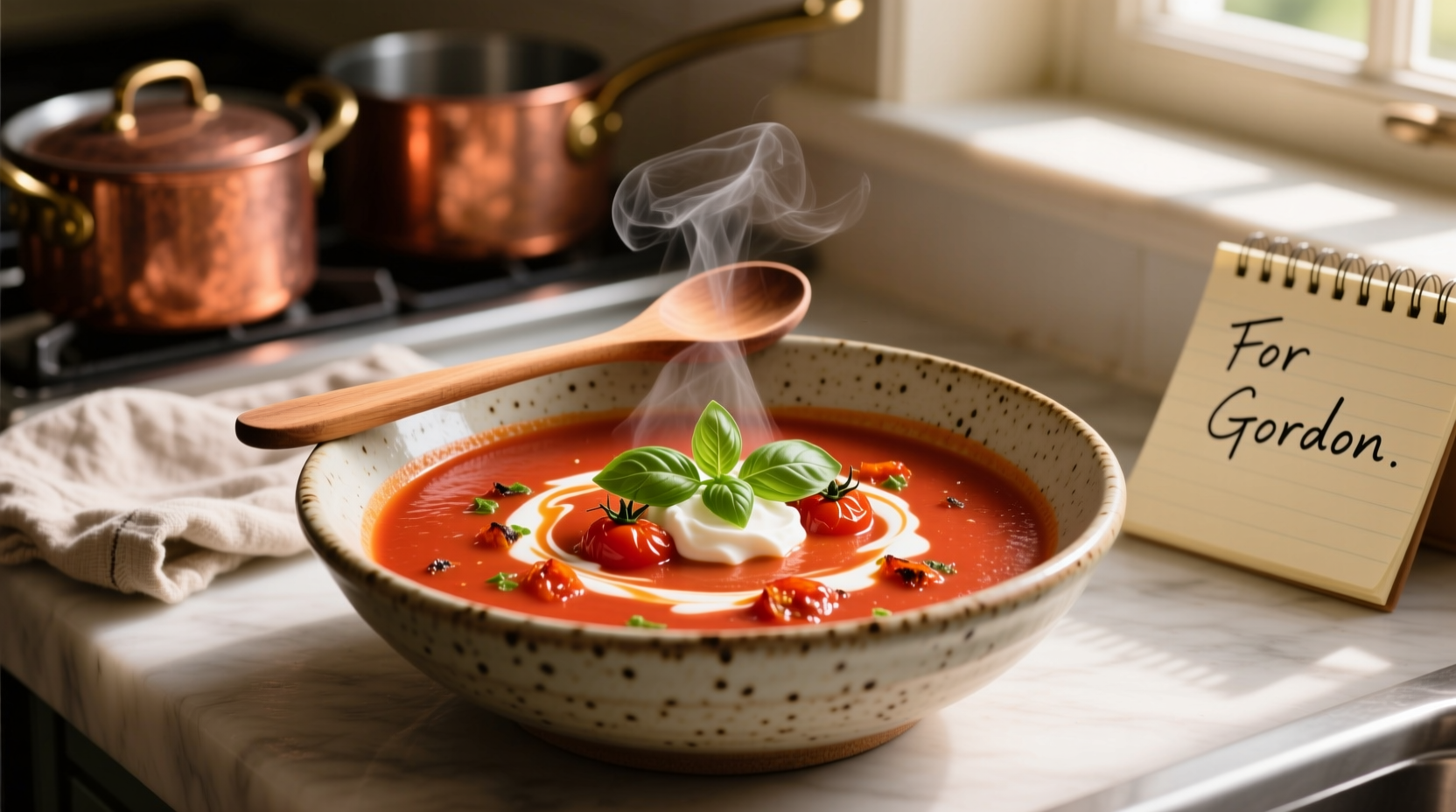Why Gordon Ramsay's Tomato Soup Stands Above the Rest
While countless tomato soup recipes exist, Gordon Ramsay's version achieves perfect balance through meticulous technique and ingredient selection. Unlike standard recipes that simply blend canned tomatoes, Ramsay's approach builds complex flavor layers starting with properly sweated aromatics and caramelized tomato paste. The result is a velvety, deeply flavorful soup with bright acidity and rich umami notes that most home versions lack.
What Makes This Recipe Different: Professional Technique Breakdown
Ramsay's tomato soup succeeds through specific techniques most home cooks miss. This comparison reveals why his method produces superior results:
| Standard Home Recipe | Gordon Ramsay's Professional Method |
|---|---|
| Sautéing vegetables until browned | Sweating vegetables slowly without color to prevent bitterness |
| Adding tomato paste directly to liquid | Caramelizing tomato paste for 3-4 minutes to develop deep flavor |
| Using regular canned tomatoes | Selecting San Marzano DOP-certified tomatoes for balanced sweetness |
| Blending without straining | Passing through fine chinois for perfectly smooth texture |
| Finishing with olive oil | Adding cold butter swirl for luxurious mouthfeel |
Authentic Gordon Ramsay Tomato Soup Recipe
Following Ramsay's exact specifications requires attention to detail. This recipe serves four and takes 45 minutes from start to finish.
Essential Ingredients and Why Quality Matters
- 2 lbs (900g) San Marzano DOP tomatoes - The Protected Designation of Origin certification ensures authentic Italian-grown tomatoes with ideal sweetness-to-acidity ratio (Consorzio San Marzano)
- 2 tbsp tomato paste - Must be caramelized properly to develop flavor depth
- 1 cup vegetable stock - Homemade preferred, but low-sodium store-bought works
- 1 small onion, finely diced - Yellow onions provide ideal sweetness balance
- 2 celery stalks, finely diced - Adds subtle herbal notes without overpowering
- 2 garlic cloves, minced - Fresh is essential; pre-minced alters flavor profile
- 3 tbsp extra virgin olive oil - Use a mild variety to avoid overpowering
- 2 tbsp unsalted butter, cold - For finishing swirl (critical texture element)
- Fresh basil leaves - 5-6 leaves for garnish and infusion
- Kosher salt and freshly ground black pepper - To taste
Step-by-Step Cooking Process
1. Proper Vegetable Sweating Technique
Heat olive oil in heavy-bottomed pot over medium-low heat. Add onions and celery with pinch of salt. Cook slowly for 8-10 minutes until translucent but not browned. This critical step develops flavor foundation without bitterness. Add garlic during last 2 minutes.
2. Caramelizing the Tomato Paste
Add tomato paste to vegetables and cook, stirring constantly, for 3-4 minutes until paste darkens slightly and smells sweet. This Maillard reaction creates complex flavor compounds essential to Ramsay's signature taste.
3. Building the Soup Base
Add tomatoes (with juices) and vegetable stock. Bring to gentle simmer, not boil. Add 4 basil leaves. Simmer uncovered for 25 minutes, stirring occasionally. Proper simmering temperature (180-190°F/82-88°C) concentrates flavors without scorching.
4. Achieving Perfect Texture
Carefully blend soup using immersion blender until smooth. For restaurant-quality texture, strain through fine-mesh sieve, pressing with ladle. This removes seeds and skin fragments that create graininess.
5. The Finishing Touch
Return soup to low heat. Season with salt and pepper. Just before serving, remove from heat and whisk in cold butter pieces one at a time. This emulsification creates luxurious mouthfeel Ramsay insists upon. Garnish with remaining fresh basil.
Common Mistakes and How to Avoid Them
Even with the right recipe, these context-specific errors can ruin your soup:
- Using high heat during vegetable stage - Browning creates bitter compounds. Maintain medium-low heat throughout sweating process
- Skipping the tomato paste caramelization - This 3-4 minute step develops 30% of the final flavor profile
- Over-blending hot soup - Creates froth and alters texture. Blend in batches if using countertop blender
- Adding dairy instead of butter finish - Cream masks tomato flavor; butter enhances it while adding richness
- Serving immediately after straining - Let soup rest 10 minutes for flavors to marry properly
Serving Suggestions for Restaurant-Quality Presentation
Ramsay typically serves this soup with:
- A swirl of high-quality extra virgin olive oil
- Fresh basil chiffonade
- Homemade croutons (never store-bought)
- Accompanied by grilled cheese sandwich using aged cheddar
For special occasions, Ramsay sometimes adds a single basil leaf fried in olive oil as elegant garnish. The soup should be served at 160°F (71°C) - hot but not scalding, allowing full flavor appreciation.

Storage and Reheating Guidelines
Proper storage maintains quality for up to 3 days:
- Cool completely before refrigerating
- Store in airtight container with plastic wrap touching soup surface
- Reheat gently over medium-low heat without boiling
- Always finish with fresh butter swirl after reheating











 浙公网安备
33010002000092号
浙公网安备
33010002000092号 浙B2-20120091-4
浙B2-20120091-4